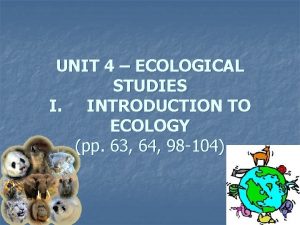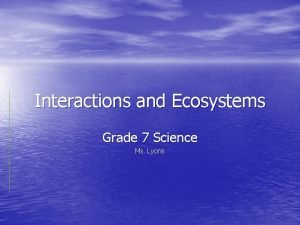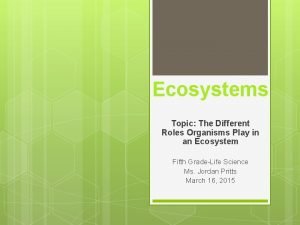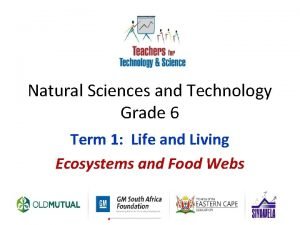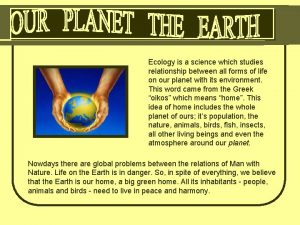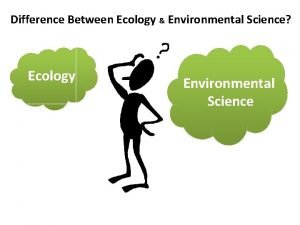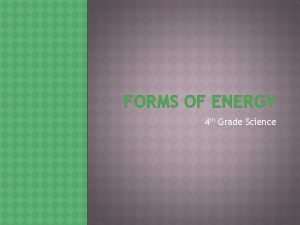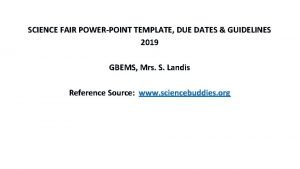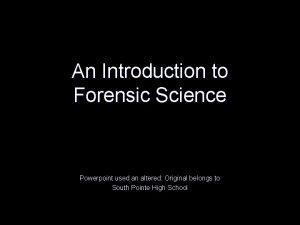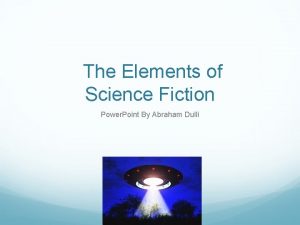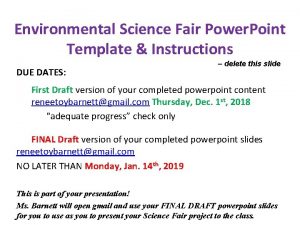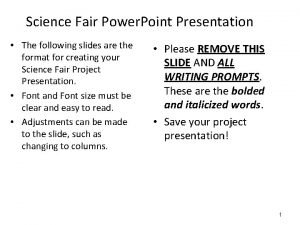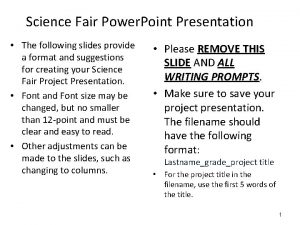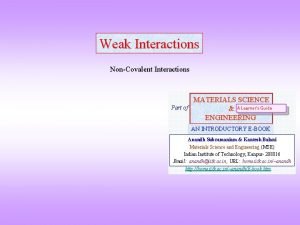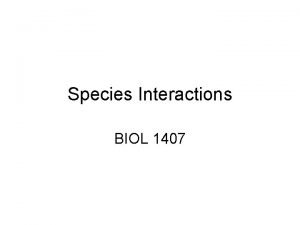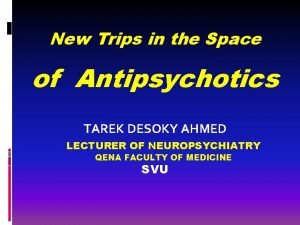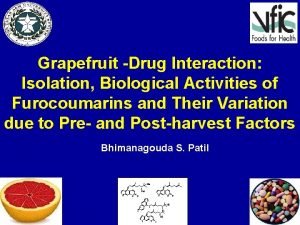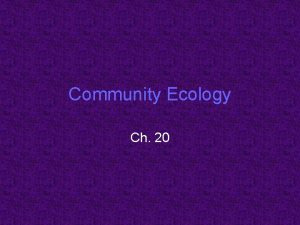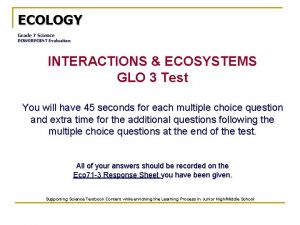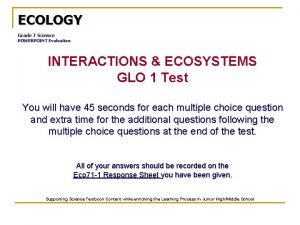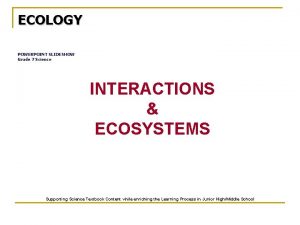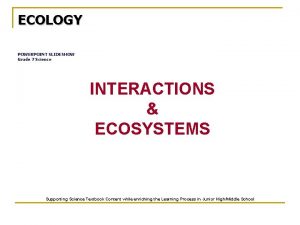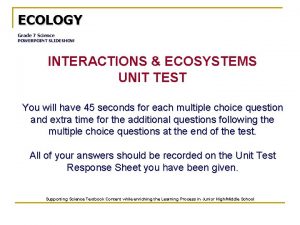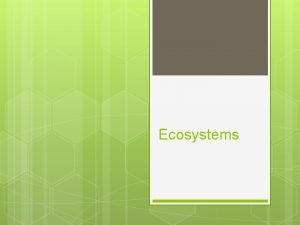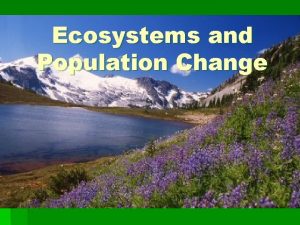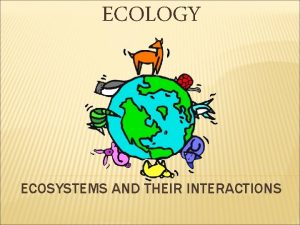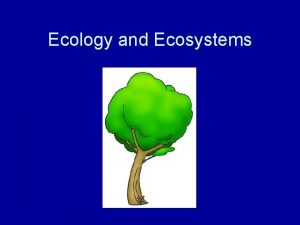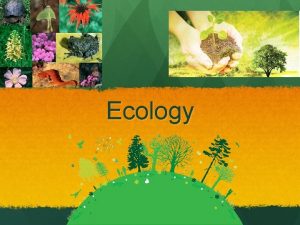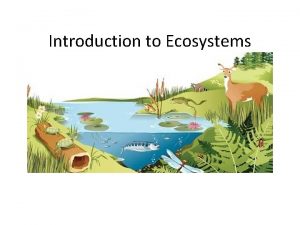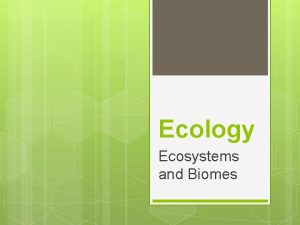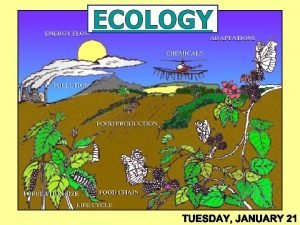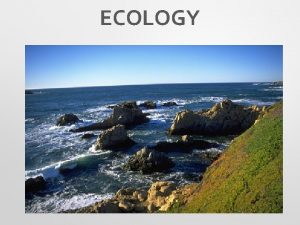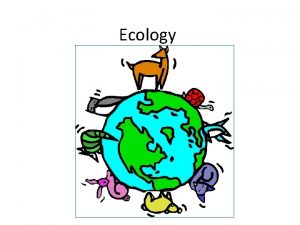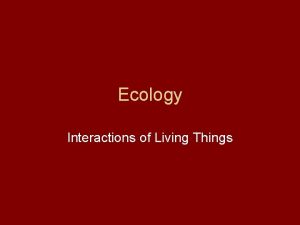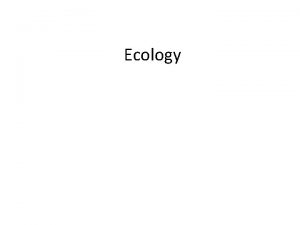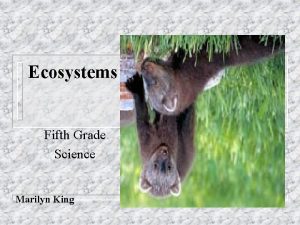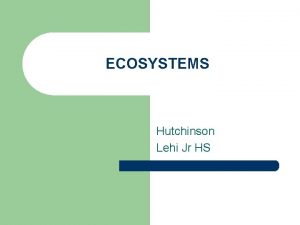ECOLOGY Grade 7 Science POWERPOINT Evaluation INTERACTIONS ECOSYSTEMS
































- Slides: 32

ECOLOGY Grade 7 Science POWERPOINT Evaluation INTERACTIONS & ECOSYSTEMS GLO 2 Test You will have 45 seconds for each multiple choice question and extra time for the additional questions following the multiple choice questions at the end of the test. All of your answers should be recorded on the Eco 71 -2 Response Sheet you have been given. Supporting Science Textbook Content while enriching the Learning Process in Junior High/Middle School

ECOLOGY 1. What effect would there be on the ecosystem we live in, if All biting insects were eliminated? A. B. C. D. Very little effect No effect at all Catastrophic effect A minor inconvenience 2. Organisms in an ecosystem can be classified as producers or consumers. The producers provide food for the consumers. An organism that consumes both producers and other consumers is called a. . . A. B. C. D. herbivore omnivore carnivore prey

ECOLOGY 3. Organisms that consume only producers are known as … A. B. C. D. herbivores omnivores carnivores predators 4. Organisms that consume other consumers are known as … A. B. C. D. herbivores omnivores carnivores producers

ECOLOGY 5. Photosynthesis is the food production process that takes place in this part of the plant … A. B. C. D. roots stem flower leaves 6. The two things that plants need - as raw materials to make food - are … A. B. C. D. nitrogen and water oxygen and carbon dioxide water and carbon dioxide nitrogen and oxygen

ECOLOGY 7. Which of the following word equations describes cellular respiration ? A. B. C. D. Light energy + carbon dioxide + water - food + oxygen Food + oxygen - carbon dioxide + water + energy Light energy + oxygen + carbon dioxide - water + food Food + carbon dioxide + energy - water + oxygen 8. Decomposers – known as the clean-up crew - are the decomposers. Scavengers also get rid of the waste in an ecosystem. Scavengers differ from decomposers because they. . . A. B. C. D. do not kill organisms for food do not eat dead organisms break down larger organisms only feed on living plants and animals

ECOLOGY 9. Which of the following decomposers are helpful? A. B. C. D. Baker’s yeast and E coli Candida albicans and nitrogen-fixing nodules E coli and E coli 0157: H 7 Candida albicans and Baker’s yeast 10. A food chain is a convenient way to show this moves among living things in an ecosystem … A. B. C. D. food sugar energy interaction

ECOLOGY 11. A food chain starts with … A. B. C. D. a small animal the consumer a primary consumer the original food source 12. Identify the correct order – showing how energy flows, from beginning to end, in a food chain that includes these organisms: 1 2 3 A. B. C. D. 1123 - 2312 - 3 2 3 1

ECOLOGY 13. Rank the following members of an ecosystem in term of their numbers. Carnivores – Herbivores - Producers Highest to lowest A. B. C. D. Herbivores - Producers - Carnivores Herbivores - Carnivores - Producers - Carnivores - Herbivores Producers - Herbivores - Carnivores 14. All the organisms included in this - indicate how many of each type of organism is included in the total energy transfer. It is referred to as a … A. B. C. D. food web food chain pyramid of biomass pyramid of numbers

ECOLOGY 15. A plant uses most of the energy it gets from the Sun to support it’s life functions. The following percentage represents the amount of energy that a plant provides to a consumer, such as a herbivore. A. B. C. D. 5% 10 % 15 % 20 % 16. Who do herbivores depend on to get the energy they need to sustain life? A. B. C. D. producers omnivores carnivores all of the above

ECOLOGY 17. What happens to ‘waste’ energy in an ecosystem? A. B. C. D. It is absorbed by plants It is absorbed by animals It is used as recycled energy It is given off into the atmosphere 18. The members of different food webs are interdependent. When changes in these occur in an ecosystem food web, which of the following would affect the members of that food web? A. B. C. D. Biotic factors only Abiotic factors only Both abiotic and biotic factors Neither biotic nor abiotic factors

ECOLOGY 19. A food web pyramid visually shows the relationships among the members of a particular food web. Which of the following would you likely see at the very top of the pyramid? A. B. C. D. herbivores omnivores carnivores producers 20. Food chains and food webs are models in science, which visually show us the different relationships within an ecosystem. The primary difference between the food chain and the food web is. . . A. B. C. D. a food chain shows how energy is stored a food web shows how energy is used a food web is a complex system of food chains a food chain is a combination of different food webs

ECOLOGY 21. In a meadow food web, like the one illustrated here: Which of the following would represent just one of the many food chains? A. B. C. D. Snail Blue heron Hawk Plants Grasshopper Raccoon Water plants Catfish Mouse Plants Snail Raccoon 22. In the meadow food web, what would happen to the owl, if a pesticide killed all of the grasshoppers? A. B. C. D. Nothing, because owls don’t eat grasshoppers They would get sick and die All the organisms in the food web will die Their population would likely increase (Their food supply would increase)

ECOLOGY 23. The light colored arrows in a food web show energy and nutrients are passed on to … A. B. C. D. decomposers carnivores herbivores producers 24. Carbon is an integral part of an ecosystem. It is cycled throughout the ecosystem as it is used and then reused. It is necessary for all life to exist. Carbon is released by plants in the process of. . . A. B. C. D. respiration photosynthesis transpiration deterioration

ECOLOGY 25. Petroleum products, which contain carbon, are burned, and the carbon escapes into the atmosphere, as carbon dioxide, BUT, how does it get into the petroleum in the first place? A. B. C. D. refineries dead plants decomposing plankton photosynthesis in plants 26. All living things need water to live. The water cycle has four main processes. The two processes that return water to the earth are. . . A. B. C. D. evaporation and condensation and precipitation transpiration and condensation evaporation and transpiration

ECOLOGY 27. The two processes that release water back into the atmosphere are. . . A. B. C. D. evaporation and condensation and precipitation transpiration and condensation evaporation and transpiration 28. The process in which water, goes through a change of state, from a gas to a liquid, is called. . . A. B. C. D. evaporation transpiration condensation precipitation

ECOLOGY 29. A Naturalist learns how to preserve and protect the natural environment. They are often referred to as our environmental. . . A. B. C. D. birdwatchers watchdogs eager beavers eyes and ears 30. This illustration represents the desalination of water. Salt is removed from the water in this process. Which cycle on the Earth does this illustration represent? A. B. C. D. The water cycle The carbon cycle The nitrogen cycle The life cycle of aquatic organisms

ECOLOGY Grade 7 Science POWERPOINT Evaluation INTERACTIONS & ECOSYSTEMS GLO 2 Test Answer Key All of your answers should be recorded on the Eco 71 -2 Response Sheet you have been given. Supporting Science Textbook Content while enriching the Learning Process in Junior High/Middle School

ECOLOGY 1. What effect would there be on the ecosystem we live in, if All biting insects were eliminated? A. B. C. D. Very little effect No effect at all Catastrophic effect A minor inconvenience 2. Organisms in an ecosystem can be classified as producers or consumers. The producers provide food for the consumers. An organism that consumes both producers and other consumers is called a. . . A. B. C. D. herbivore omnivore carnivore prey

ECOLOGY 3. Organisms that consume only producers are known as … A. B. C. D. herbivores omnivores carnivores predators 4. Organisms that consume other consumers are known as … A. B. C. D. herbivores omnivores carnivores producers

ECOLOGY 5. Photosynthesis is the food production process that takes place in this part of the plant … A. B. C. D. roots stem flower leaves 6. The two things that plants need - as raw materials to make food - are … A. B. C. D. nitrogen and water oxygen and carbon dioxide water and carbon dioxide nitrogen and oxygen

ECOLOGY 7. Which of the following word equations describes cellular respiration ? A. B. C. D. Light energy + carbon dioxide + water - food + oxygen Food + oxygen - carbon dioxide + water + energy Light energy + oxygen + carbon dioxide - water + food Food + carbon dioxide + energy - water + oxygen 8. Decomposers – known as the clean-up crew - are the decomposers. Scavengers also get rid of the waste in an ecosystem. Scavengers differ from decomposers because they. . . A. B. C. D. do not kill organisms for food do not eat dead organisms break down larger organisms only feed on living plants and animals

ECOLOGY 9. Which of the following decomposers are helpful? A. B. C. D. Baker’s yeast and E coli Candida albicans and nitrogen-fixing nodules E coli and E coli 0157: H 7 Candida albicans and Baker’s yeast 10. A food chain is a convenient way to show this moves among living things in an ecosystem … A. B. C. D. food sugar energy interaction

ECOLOGY 11. A food chain starts with … A. B. C. D. a small animal the consumer a primary consumer the original food source 12. Identify the correct order – showing how energy flows, from beginning to end, in a food chain that includes these organisms: 1 2 3 A. B. C. D. 1123 - 2312 - 3 2 3 1

ECOLOGY 13. Rank the following members of an ecosystem in term of their numbers. Carnivores – Herbivores - Producers Highest to lowest A. B. C. D. Herbivores - Producers - Carnivores Herbivores - Carnivores - Producers - Carnivores - Herbivores Producers - Herbivores - Carnivores 14. All the organisms included in this - indicate how many of each type of organism is included in the total energy transfer. It is referred to as a … A. B. C. D. food web food chain pyramid of biomass pyramid of numbers

ECOLOGY 15. A plant uses most of the energy it gets from the Sun to support it’s life functions. The following percentage represents the amount of energy that a plant provides to a consumer, such as a herbivore. A. B. C. D. 5% 10 % 15 % 20 % 16. Who do herbivores depend on to get the energy they need to sustain life? A. B. C. D. producers omnivores carnivores all of the above

ECOLOGY 17. What happens to ‘waste’ energy in an ecosystem? A. B. C. D. It is absorbed by plants It is absorbed by animals It is used as recycled energy It is given off into the atmosphere 18. The members of different food webs are interdependent. When changes in these occur in an ecosystem food web, which of the following would affect the members of that food web? A. B. C. D. Biotic factors only Abiotic factors only Both abiotic and biotic factors Neither biotic nor abiotic factors

ECOLOGY 19. A food web pyramid visually shows the relationships among the members of a particular food web. Which of the following would you likely see at the very top of the pyramid? A. B. C. D. herbivores omnivores carnivores producers 20. Food chains and food webs are models in science, which visually show us the different relationships within an ecosystem. The primary difference between the food chain and the food web is. . . A. B. C. D. a food chain shows how energy is stored a food web shows how energy is used a food web is a complex system of food chains a food chain is a combination of different food webs

ECOLOGY 21. In a meadow food web, like the one illustrated here: Which of the following would represent just one of the many food chains? A. B. C. D. Snail Blue heron Hawk Plants Grasshopper Raccoon Water plants Catfish Mouse Plants Snail Raccoon 22. In the meadow food web, what would happen to the owl, if a pesticide killed all of the grasshoppers? A. B. C. D. Nothing, because owls don’t eat grasshoppers They would get sick and die All the organisms in the food web will die Their population would likely increase (Their food supply would increase)

ECOLOGY 23. The light colored arrows in a food web show energy and nutrients are passed on to … A. B. C. D. decomposers carnivores herbivores producers 24. Carbon is an integral part of an ecosystem. It is cycled throughout the ecosystem as it is used and then reused. It is necessary for all life to exist. Carbon is released by plants in the process of. . . A. B. C. D. respiration photosynthesis transpiration deterioration

ECOLOGY 25. Petroleum products, which contain carbon, are burned, and the carbon escapes into the atmosphere, as carbon dioxide, BUT, how does it get into the petroleum in the first place? A. B. C. D. refineries dead plants decomposing plankton photosynthesis in plants 26. All living things need water to live. The water cycle has four main processes. The two processes that return water to the earth are. . . A. B. C. D. evaporation and condensation and precipitation transpiration and condensation evaporation and transpiration

ECOLOGY 27. The two processes that release water back into the atmosphere are. . . A. B. C. D. evaporation and condensation and precipitation transpiration and condensation evaporation and transpiration 28. The process in which water, goes through a change of state, from a gas to a liquid, is called. . . A. B. C. D. evaporation transpiration condensation precipitation

ECOLOGY 29. A Naturalist learns how to preserve and protect the natural environment. They are often referred to as our environmental. . . A. B. C. D. birdwatchers watchdogs eager beavers eyes and ears 30. This illustration represents the desalination of water. Salt is removed from the water in this process. Which cycle on the Earth does this illustration represent? A. B. C. D. The water cycle The carbon cycle The nitrogen cycle The life cycle of aquatic organisms
 Interactions within ecosystems grade 7
Interactions within ecosystems grade 7 Which of the following tells you population density
Which of the following tells you population density Heterotrophs
Heterotrophs Ecosystems interactions
Ecosystems interactions Phosphorus cycle pearson education
Phosphorus cycle pearson education Chapter 55 ecosystems and restoration ecology
Chapter 55 ecosystems and restoration ecology Grade 7 ecosystems
Grade 7 ecosystems Ecosystems jeopardy 5th grade
Ecosystems jeopardy 5th grade Ecosystem grade 6
Ecosystem grade 6 What is my favourite subject
What is my favourite subject Ecology is a science which studies the relationship between
Ecology is a science which studies the relationship between Difference between ecology and environment
Difference between ecology and environment Forms of energy powerpoint 5th grade
Forms of energy powerpoint 5th grade Natural science grade 7 lesson plans term 2
Natural science grade 7 lesson plans term 2 Science fair data table template
Science fair data table template History of forensic science ppt
History of forensic science ppt Elements of science fiction
Elements of science fiction Science expo background
Science expo background Science fair powerpoint presentation examples
Science fair powerpoint presentation examples Science fair powerpoint presentation examples
Science fair powerpoint presentation examples Noncovalent interactions
Noncovalent interactions Congress formal and informal powers
Congress formal and informal powers Adelphoparasitism
Adelphoparasitism Types of species interactions
Types of species interactions Group studied is smaller and not randomly selected
Group studied is smaller and not randomly selected Sertraline interactions
Sertraline interactions Expansionary monetary policy effects
Expansionary monetary policy effects The properties and interactions of magnets are called
The properties and interactions of magnets are called Felodapine
Felodapine Abiotic components
Abiotic components How do earth's spheres interact
How do earth's spheres interact Section 20-1 review species interactions
Section 20-1 review species interactions Photosynthesis is important to animals because flocabulary
Photosynthesis is important to animals because flocabulary


